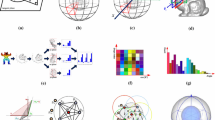Abstract
A novel approach is proposed to recognize non-rigid 3D objects from 2D images using principal component analysis and geometric hashing. For all of the models that we want to be able to recognize, we calculate the statistic of point features using principal component analysis and then, calculate the invariants of them. In recognition stage, we calculate the needed invariants from an unknown image and used as indexing keys to retrieve from the model base the possible matches with the model features. We hypothesize the existence of an instance of the model if a model's features scores enough hits on the vote count.
Preview
Unable to display preview. Download preview PDF.
Similar content being viewed by others
References
A.M. Baumberg and D.C. Hogg, Learning Flexible Models from Image Sequences, Report 93.36, Division of A.I., School of Computer Studies, University of Leeds.
B. Lamiroy and P. Gros, “Rapid Object Indexing and Recognition using Enhanced Geometric Hashing,” Lectures Notes in Computer Science 1064, (B. Buxton and R. Cipolla, Ed.), pp. 59–70, Springer-Verlag, Berlin, 1996.
D.F. Rogers, and J.A. Adams, Mathematical Elements for Computer Graphics, 2nd ed. McGraw-Hill International Editions,1990.
I. Rigoutsos, Massively Parallel Bayesian Object Recognition, Ph.D thesis, New York University, 1992.
P. Havaldar, G. Medioni, and F. Stein, “Extraction of Groups for Recognition,” in Lectures Notes in Computer Science 800, (Jan-Olof Eklundh, Ed.), pp. 251–261, Springer-Verlag, Berlin, 1994.
R. Chin and C.R. Dryer, “Model-Based Recognition in Robot Vision,” Computing Surveys, Vol. 18, no.1.
T.F Cootes, C.J. Taylor, D.H. Cooper, and J. Graham, “Training Models of Shape from Sets of Examples,” In Proc. British Machine Vision Conference, pp. 9–18, Springer-Verlag, 1992.
T.F Cootes, A. Hill, C.J. Taylor, and J. Haslam, “The Use of Active Shape Models for Locating Structures in Medical Images,” Image and Vision Computing, Vol. 12, No. 6, pp. 355–366, 1994.
W.E.L. Grimson, Object Recognition by Computer — The Role of Geometric Constraints, The MIT Press, Cambridge, MA, USA, 1990.
Y.C. Hecker, and R.M. Bolle, “On Geometric Hashing and the Generalized Hough Transform,” IEEE Transactions on System, Man, and Cybernetics, Vol.24, No.9, pp.1328–1338, 1994.
Y. Lamdan, J.T. Schwartz, and H.J. Wolfson, “Affine Invariant Model-based Object Recognition,” IEEE Transactions on Robotics and Automation, Vol. 6, No.5, pp. 578–589, 1990.
Y. Lamdan, and H.J. Wolfson, Geometric hashing: A general and efficient modelbased recognition scheme. In Proceedings of the Second International Conference on Computer Vision, pages 238–249, 1988. Tarpon Springs (Fl.)
Author information
Authors and Affiliations
Editor information
Rights and permissions
Copyright information
© 1997 Springer-Verlag Berlin Heidelberg
About this paper
Cite this paper
Surendro, K., Anzai, Y. (1997). Non-rigid object recognition using principal component analysis and geometric hashing. In: Sommer, G., Daniilidis, K., Pauli, J. (eds) Computer Analysis of Images and Patterns. CAIP 1997. Lecture Notes in Computer Science, vol 1296. Springer, Berlin, Heidelberg. https://doi.org/10.1007/3-540-63460-6_99
Download citation
DOI: https://doi.org/10.1007/3-540-63460-6_99
Published:
Publisher Name: Springer, Berlin, Heidelberg
Print ISBN: 978-3-540-63460-7
Online ISBN: 978-3-540-69556-1
eBook Packages: Springer Book Archive




